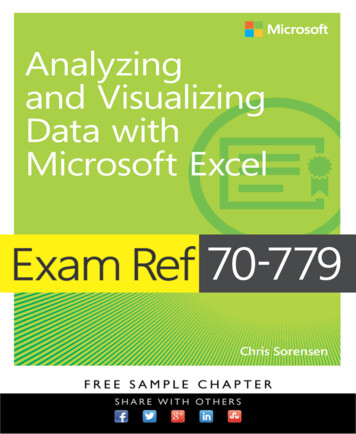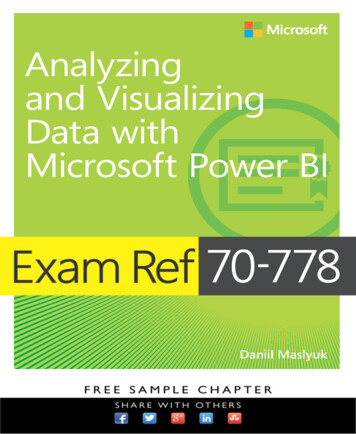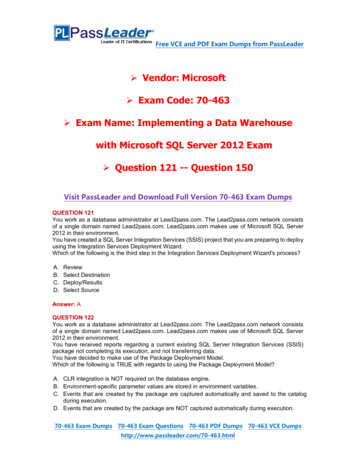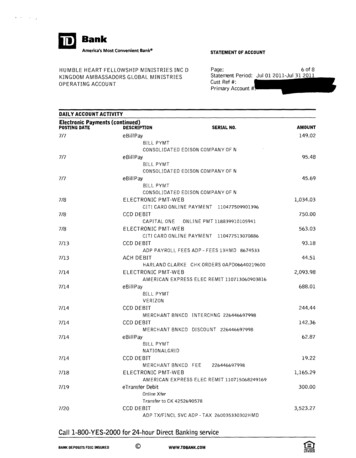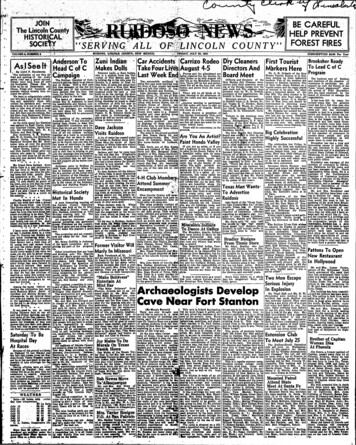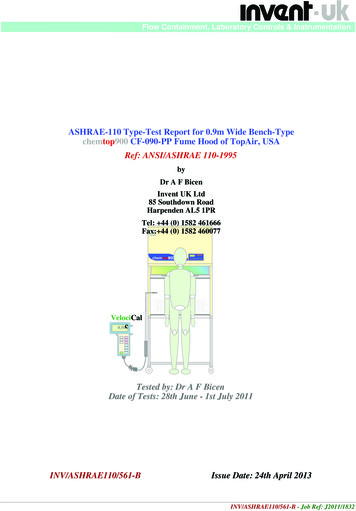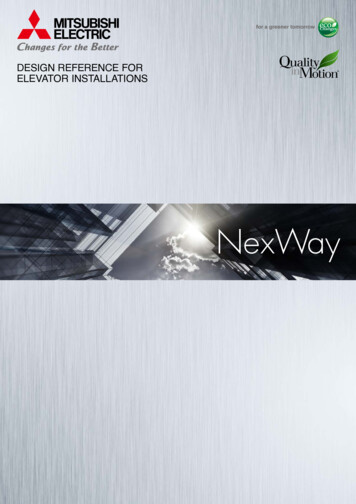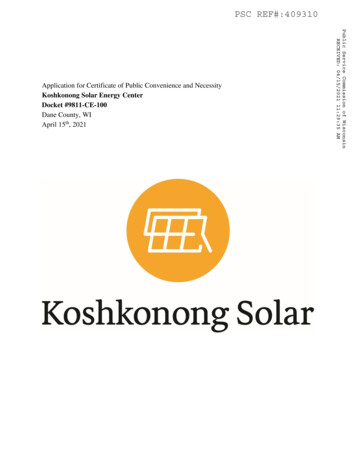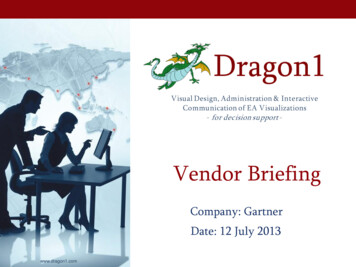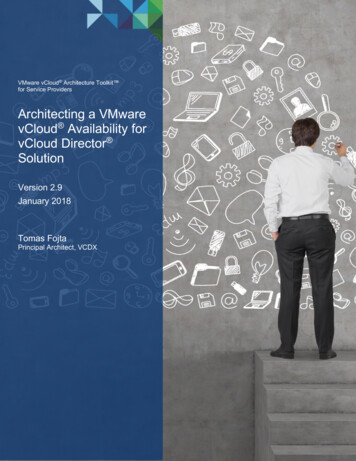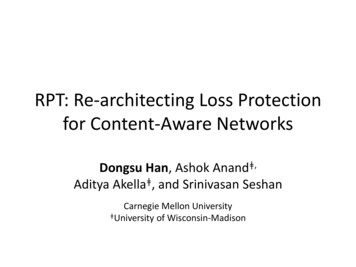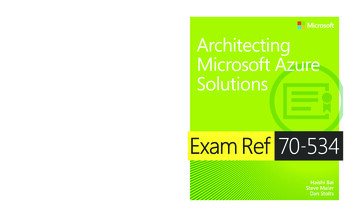
Transcription
Prepare for Microsoft Exam 70-534—and help demonstrate yourreal-world mastery of Microsoft Azure solution design andarchitecture. Designed for experienced IT pros ready to advancetheir status, Exam Ref focuses on the critical-thinking anddecision-making acumen needed for success at the MicrosoftSpecialist level.Focus on the expertise measured by theseobjectives: Describe Microsoft Azure infrastructure and networking Help secure resources Design an application storage and data access strategy Design an advanced application Design websites Design a management, monitoring, and business continuity strategyThis Microsoft Exam Ref: Organizes its coverage by exam objectives Features strategic, what-if scenarios to challenge you Assumes you have experience designing Microsoft Azurecloud or hybrid solutions and supporting application life cycle management5 3 9 9 9U.S.A. 39.99Canada 45.99[Recommended]9780735 6974479780735697447 ER70 534 cover.indd 1About the ExamExam 70-534 focuses on the skills andknowledge needed to design effectiveMicrosoft Azure public and hybrid cloudsolutions.About MicrosoftCertificationPassing this exam earns you a MicrosoftSpecialist certification in MicrosoftAzure, demonstrating your expertisewith the Microsoft Azure enterprisegrade cloud platform.You can earn this certification by passingExam 70-532, Developing MicrosoftAzure Solutions; or Exam 70-533, Implementing Microsoft Azure InfrastructureSolutions; or Exam 70-534, ArchitectingMicrosoft Azure Solutions.See full details at:microsoft.com/learningAbout the AuthorsHaishi Bai, Senior Technical Evangelistat Microsoft, focuses on the MicrosoftAzure compute platform, including IaaS,PaaS, networking, and scalable computing services.Steve Maier, Senior Technical Evangelistat Microsoft, specializes in MicrosoftAzure.Dan Stolts, Senior Technical Evangelistat Microsoft, is a technology expert proficient in datacenter technologies.microsoft.com/mspressISBN 978-0-7356-9744-7Architecting MicrosoftAzure SolutionsCertification/Microsoft AzureExam Ref Architecting MicrosoftAzure Solutions70-534Exam Ref 70-534BaiMaierStoltsArchitectingMicrosoft AzureSolutionsExam Ref 70 534Haishi BaiSteve MaierDan Stolts5/4/2015 1:39:43 PM
Architecting Microsoft AzureSolutionsExam Ref 70-534Haishi BaiSteve MaierDan Stolts697447 ER70-534.indb i5/5/2015 1:59:23 PM
PUBLISHED BYMicrosoft PressA division of Microsoft CorporationOne Microsoft WayRedmond, Washington 98052-6399Copyright 2015 by Microsoft CorporationAll rights reserved. No part of the contents of this book may be reproduced ortransmitted in any form or by any means without the written permission of thepublisher.Library of Congress Control Number: 2014958516ISBN: 978-0-7356-9744-7Printed and bound in the United States of America.First PrintingMicrosoft Press books are available through booksellers and distributorsworldwide. If you need support related to this book, email Microsoft PressSupport at mspinput@microsoft.com. Please tell us what you think of this bookat http://aka.ms/tellpress.This book is provided “as-is” and expresses the author’s views and opinions. Theviews, opinions and information expressed in this book, including URL and otherInternet website references, may change without notice.Some examples depicted herein are provided for illustration only and are fictitious.No real association or connection is intended or should be inferred.Microsoft and the trademarks listed at ctualProperty/Trademarks/EN-US.aspx are trademarks of the Microsoftgroup of companies. All other marks are property of their respective owners.Acquisitions Editor: Karen SzallDevelopmental Editor: Karen SzallEditorial Production: Dianne Russell, Octal Publishing, Inc.Technical Reviewer: Roberto Freato; Technical Review services provided byContent Master, a member of CM Group, Ltd.Copyeditor: Bob Russell, Octal Publishing, Inc.Indexer: Ellen Troutman, Octal Publishing, Inc.Cover: Twist Creative Seattle697447 ER70-534.indb ii5/5/2015 1:59:26 PM
Contents at a glanceMicrosoft certificationsxvPreparing for the examxviiiCHAPTER 1Design Microsoft Azure infrastructure and networkingCHAPTER 2Secure resourcesCHAPTER 3Design an application storage and data access strategy129CHAPTER 4Design an advanced application189CHAPTER 5Design Web Apps251CHAPTER 6Design a management, monitoring, and businesscontinuity strategyIndex697447 ER70-534.indb iii1633053815/5/2015 1:59:26 PM
697447 ER70-534.indb iv5/5/2015 1:59:26 PM
ContentsIntroductionChapter 1xvMicrosoft certificationsxvAcknowledgmentsxviFree ebooks from Microsoft PressxviMicrosoft Virtual AcademyxviErrata, updates, & book supportxviWe want to hear from youxviiStay in touchxviiPreparing for the examxviiiDesign Microsoft Azure infrastructure andnetworking1Objective 1.1: Describe how Azure uses Global FoundationServices (GFS) datacenters . . . . . . . . . . . . . . . . . . . . . . . . . . . . . . . . . . . . . . . 2Azure’s global footprints2Designing cloud-scale datacenters4Designing for the cloud8Objective summary11Objective review12Objective 1.2: Design Azure virtual networks, networking services,DNS, DHCP, and IP addressing configuration. . . . . . . . . . . . . . . . . . . . . . 12Creating a cloud-only virtual network13Understanding Access Control Lists and Network SecurityGroups18Objective summary22Objective review22What do you think of this book? We want to hear from you!Microsoft is interested in hearing your feedback so we can continually improve ourbooks and learning resources for you. To participate in a brief online survey, please 7 ER70-534.indb v5/5/2015 1:59:26 PM
Objective 1.3: Design Azure Compute . . . . . . . . . . . . . . . . . . . . . . . . . . . . . . 23Selecting VM sizes24Managing images31Managing VM states33Capturing infrastructure as code36Scaling applications on VMs40Objective summary44Objective review44Objective 1.4: Describe Azure virtual private network (VPN)and ExpressRoute architecture and design . . . . . . . . . . . . . . . . . . . . . . . . 45Designing hybrid solutions with Virtual Network andExpressRoute45ExpressRoute48vNet-to-vNet VPN49Multi-site VPN50Understanding other hybrid solution options51Objective summary52Objective review52Objective 1.5: Describe Azure Services . . . . . . . . . . . . . . . . . . . . . . . . . . . . . . 52Using Azure Traffic Manager53Using CDN54Objective summary55Objective review55Answers . . . . . . . . . . . . . . . . . . . . . . . . . . . . . . . . . . . . . . . . . . . . . . . . . . . . . . . . . 56viObjective 1.1: Thought experiment56Objective 1.1: Review56Objective 1.2: Thought experiment57Objective 1.2: Review57Objective 1.3: Thought experiment58Objective 1.3: Review58Objective 1.4: Thought experiment59Objective 1.4: Review59Objective 1.5: Thought experiment60Objective 1.5: Review60Contents697447 ER70-534.indb vi5/5/2015 1:59:26 PM
Chapter 2Secure resources63Objective 2.1: Secure resources by using managed identities . . . . . . . . . . 63Understanding claims-based architecture64Understanding basic authentication and authorizationworkflow66Working with native clients and multitiered applications67Working with multitiered applications68Additional scenarios69Azure Active Directory69A sample scenario with ADAL and Visual Studio71Azure AD Graph API74Objective summary76Objective review76Objective 2.2: Secure resources by using hybrid identities . . . . . . . . . . . . . 77Setting up directory synchronization with AD FS77Configuring Azure AD Application Proxy82Objective summary85Objective review86Objective 2.3: Secure resources by using identity providers . . . . . . . . . . . . 86Understanding Azure ACS87Using Azure ACS with AD FS89Using Azure ACS with social networks90Using identity providers with ASP.NET applications90Using external identity providers with Azure Mobile Services94Objective summary94Objective review95Objective 2.4: Identify an appropriate data security solution . . . . . . . . . . . 95Understanding data protection technologiesImplementing effective access control policies9698Using data reliability and disaster recovery services102Understanding Azure Rights Management Services106Managing security keys with Azure Key Vault107Objective summary108Objective review108Contents697447 ER70-534.indb viivii5/5/2015 1:59:26 PM
Objective 2.5: Design a role-based access control strategy . . . . . . . . . . . 109Understanding access control challenges faced by largeenterprises109Implementing RBAC110Using RBAC for Azure resources111Empowering users with self-service112Using Azure AD Access Panel115Managing devices with Azure AD Device Registration Service116Improving security policies over time117Objective summary120Objective review120Answers . . . . . . . . . . . . . . . . . . . . . . . . . . . . . . . . . . . . . . . . . . . . . . . . . . . . . . . . 122Chapter 3Objective 2.1: Thought experiment122Objective 2.1: Review122Objective 2.2: Thought experiment123Objective 2.2: Review123Objective 2.3: Thought experiment124Objective 2.3: Review124Objective 2.4: Thought experiment125Objective 2.4: Review126Objective 2.5: Thought experiment127Objective 2.5: Review127Design an application storage and data accessstrategy129Objective 3.1: Design data storage . . . . . . . . . . . . . . . . . . . . . . . . . . . . . . . . 129Designing storage options for data130Designing security options for SQL Database or Storage136Identifying the appropriate VM type and size for the solution137Objective summary139Objective review140Objective 3.2: Design applications that use Mobile Services . . . . . . . . . . 141viiiAzure Mobile Services141Consuming Mobile Services143Contents697447 ER70-534.indb viii5/5/2015 1:59:26 PM
Offline Sync145Implementing Mobile Services147Secure Mobile Services148Extending Mobile Services by using custom code150Objective summary151Objective review151Objective 3.3: Design applications that use notifications . . . . . . . . . . . . . 153Implementing push notification services in Mobile Services153Sending push notifications155Objective summary157Objective review157Objective 3.4: Design applications that use a web API. . . . . . . . . . . . . . . . 158Implementing a custom Web API159Scaling by using Azure App Service Web Apps161WebJobs163Securing a Web API165Objective summary167Objective review168Objective 3.5: Design a data access strategy for hybrid applications . . . 168Connect to on-premises data by using Azure ServiceBus Relay169Azure App Service BizTalk API Apps Hybrid Connections170Web Apps virtual private network capability171Identify constraints for connectivity with VPN172Identify options for domain-joining Azure Virtual Machinesand Cloud Services172Objective summary174Objective review174Objective 3.6: Design a media solution. . . . . . . . . . . . . . . . . . . . . . . . . . . . . 175Azure Media Services overview175Key components of Media Services176Objective summary179Objective review179Contents697447 ER70-534.indb ixix5/5/2015 1:59:26 PM
Answers . . . . . . . . . . . . . . . . . . . . . . . . . . . . . . . . . . . . . . . . . . . . . . . . . . . . . . . 180Chapter 4Objective 3.1: Thought experiment180Objective 3.1: Review180Objective 3.2: Thought experiment181Objective 3.2: Review181Objective 3.3: Thought experiment183Objective 3.3: Review183Objective 3.4: Thought experiment184Objective 3.4: Review185Objective 3.5: Thought experiment185Objective 3.5: Review186Objective 3.6: Thought experiment187Objective 3.6: Review187Design an advanced application189Objective 4.1: Create compute-intensive applications . . . . . . . . . . . . . . . . 190Using Azure in a high-performance computing environment190Using Azure Batch193Understanding Azure Batch Apps199Implementing the Competing Consumers pattern200Objective summary202Objective review202Objective 4.2: Create long-running applications . . . . . . . . . . . . . . . . . . . . 203Designing available applications203Designing reliable applications207Designing scalable applications211Using Azure Autoscale213Using Cloud Services215Sample scenario: Cloud Services basics217Objective summary220Objective review220Objective 4.3: Select the appropriate storage option . . . . . . . . . . . . . . . . 221xUnderstanding data access patterns222Selecting a data storage solution224Contents697447 ER70-534.indb x5/5/2015 1:59:26 PM
Evaluating data storage qualities226Objective summary228Objective review228Objective 4.4: Integrate Azure services in a solution . . . . . . . . . . . . . . . . . 229Creating data-centric web applications230Working with Big Data and the Internet of Things233Building enterprise mobile applications236Creating media applications238Managing related services240Objective summary241Objective review242Answers . . . . . . . . . . . . . . . . . . . . . . . . . . . . . . . . . . . . . . . . . . . . . . . . . . . . . . . . 243Chapter 5Objective 4.1: Thought experiment243Objective 4.1: Review243Objective 4.2: Thought experiment244Objective 4.2: Review244Objective 4.3: Thought experiment246Objective 4.3: Review246Objective 4.4: Thought experiment247Objective 4.4: Review248Design Web Apps251Objective 5.1: Design web applications for scalability and performance 252Globally scale websites252Create websites using Microsoft Visual Studio254Debug websites257Understand supported languages259App Service Web Apps, Azure Virtual Machines, and Azure CloudServices263Objective summary268Objective review268Objective 5.2: Deploy websites . . . . . . . . . . . . . . . . . . . . . . . . . . . . . . . . . . . . 268Implement Azure Site Extensions269Create packages271Contents697447 ER70-534.indb xixi5/5/2015 1:59:26 PM
App Service Plan273Deployment slots275Resource groups277Publishing options278Objective summary285Objective review285Objective 5.3: Design websites for business continuity . . . . . . . . . . . . . . . 286Scale-up and scale-out with App Service Web Apps and Azure SQLDatabase287Configure data replication patterns289Update websites with minimal downtime291Backup and restore data291Design for disaster recovery294Deploy websites to multiple regions for high availability294Design data tier296Objective summary298Objective review299Answers . . . . . . . . . . . . . . . . . . . . . . . . . . . . . . . . . . . . . . . . . . . . . . . . . . . . . . . . 300Chapter 6Objective 5.1: Thought experiment300Objective 5.1: Review300Objective 5.2: Thought experiment301Objective 5.2: Review302Objective 5.3: Thought experiment303Objective 5.3: Review303Design a management, monitoring, and businesscontinuity strategy305Objective 6.1: Evaluate hybrid and Azure-hosted architecturesfor Microsoft System Center deployment . . . . . . . . . . . . . . . . . . . . . . . . 306xiiUnderstanding System Center components supportedin Azure306System Center deployment309Design considerations for managing Azure resources withSystem Center310Contents697447 ER70-534.indb xii5/5/2015 1:59:27 PM
Understanding which scenarios dictate a hybrid scenario312Objective summary315Objective review315Objective 6.2: Design a monitoring strategy . . . . . . . . . . . . . . . . . . . . . . . . 316Identify the Microsoft products and services for monitoringAzure solutions317Understand the capabilities of System Center for monitoringan Azure solution317Understand built-in Azure capabilities322Identify third-party monitoring tools, including open source323Describe use-cases for Operations Manager, Global ServiceMonitor, and Application Insights323Describe the use cases for WSUS, Configuration Manager,and custom solutions325Describe the Azure architecture constructs and how theyaffect a patching strategy327Objective summary329Objective review330Objective 6.3: Design Azure business continuity/disaster recovery(BC/DR) capabilities . . . . . . . . . . . . . . . . . . . . . . . . . . . . . . . . . . . . . . . . . . . 330Understand the architectural capabilities of businesscontinuity and disaster recovery331Describe Hyper-V Replica and Azure Site Recovery336Describe use-cases for Hyper-V Replica and Azure SiteRecovery338Objective summary340Objective review340Objective 6.4: Design a disaster recovery strategy . . . . . . . . . . . . . . . . . . . 341Design and deploy Azure Backup and other Microsoftbackup solutions for Azure342Understand use-cases when StorSimple and Data ProtectionManager would be appropriate351Objective summary352Objective review353Contents697447 ER70-534.indb xiiixiii5/5/2015 1:59:27 PM
Objective 6.5: Design Azure Automation and PowerShell workflows . . . 354Create a Windows PowerShell script specific to Azure354Objective summary363Objective review364Objective 6.6: Describe the use cases for Azure Automationconfiguration . . . . . . . . . . . . . . . . . . . . . . . . . . . . . . . . . . . . . . . . . . . . . . . . 365Desired State Configuration366Windows PowerShell for automation368Chef and Puppet368Azure Automation369Objective summary370Objective review370Answers . . . . . . . . . . . . . . . . . . . . . . . . . . . . . . . . . . . . . . . . . . . . . . . . . . . . . . . . 372Objective 6.1: Thought experiment372Objective 6.1: Review372Objective 6.2: Thought experiment373Objective 6.2: Review374Objective 6.3: Thought experiment374Objective 6.3: Review375Objective 6.4: Thought experiment376Objective 6.4: Review376Objective 6.5: Thought experiment377Objective 6.5: Review377Objective 6.6: Thought experiment378Objective 6.6: Review379Index381What do you think of this book? We want to hear from you!Microsoft is interested in hearing your feedback so we can continually improve ourbooks and learning resources for you. To participate in a brief online survey, please tents697447 ER70-534.indb xiv5/5/2015 1:59:27 PM
IntroductionMost books take a very low-level approach, teaching you how to use individual classes andaccomplish fine-grained tasks. This book takes a high-level architectural view, building onyour knowledge of lower-level Microsoft Azure systems management experience and content. Both the exam and the book are so high-level, in fact, that there are very few step-bystep instructions involved. There is some coding (Windows PowerShell and Azure PowerShell)but it is minimized to getting started with managing Azure with PowerShell and an introduction to how you can use Windows and Azure PowerShell to design, build, and deploy systems in the Azure cloud. The Exam Ref has a huge advantage over other study mechanisms:It demonstrates what is on the exam while also helping you to understand what it takes todesign systems in real-world scenarios.This book covers every exam objective, but it does not cover every exam question. Onlythe Microsoft exam team has access to the exam questions themselves and Microsoft regularly adds new questions to the exam, making it impossible to cover specific questions. Youshould consider this book a supplement to your relevant real-world experience and otherstudy materials. If you encounter a topic in this book that you do not feel completely comfortable with, use the links you’ll find in the text to gain access to more information and takethe time to research and study the topic. Great information is available on MSDN, TechNet,and in blogs and forums.Microsoft certificationsMicrosoft certifications distinguish you by proving your command of a broad set of skills andexperience with current Microsoft products and technologies. The exams and correspondingcertifications are developed to validate your mastery of critical competencies as you designand develop, or implement and support, solutions with Microsoft products and technologies,both on-premises and in the cloud. Certification brings a variety of benefits to the individualand to employers and organizations.MORE INFOALL MICROSOFT CERTIFICATIONSFor information about Microsoft certifications, including a full list of available certifications, go to http://www.microsoft.com/learning.xv697447 ER70-534.indb xv5/5/2015 1:59:27 PM
AcknowledgmentsIt takes many people to make a book, and even more to make a technical exam reference.Thanks to the content authors: Haishi Bai (http://haishibai.blogspot.com) Steve Maier (http://42base13.net) Dan Stolts (http://ITProGuru.com)You can visit them and follow them on their blogs. Thanks to content providers and editors: Karen Szall, Devon Musgrave, Roberto Freato, and Bob Russell. Thanks to all those atMicrosoft Press and Microsoft Learning for driving this certification, content, and resultingbook. Most of all, thank you, for taking the time to learn about Azure cloud architecturethrough this exam reference guide.Free ebooks from Microsoft PressFrom technical overviews to in-depth information on special topics, the free ebooks fromMicrosoft Press cover a wide range of topics. These ebooks are available in PDF, EPUB, andMobi for Kindle formats, ready for you to download at:http://aka.ms/mspressfreeCheck back often to see what is new!Microsoft Virtual AcademyBuild your knowledge of Microsoft technologies with free expert-led online training fromMicrosoft Virtual Academy (MVA). MVA offers a comprehensive library of videos, live events,and more to help you learn the latest technologies and prepare for certification exams. You’llfind what you need here:http://www.microsoftvirtualacademy.comErrata, updates, & book supportWe’ve made every effort to ensure the accuracy of this book and its companion content. Youcan access updates to this book—in the form of a list of submitted errata and their If you discover an error that is not already listed, please submit it to us at the same page.xvi Introduction697447 ER70-534.indb xvi5/5/2015 1:59:27 PM
If you need additional support, email Microsoft Press Book Support at mspinput@microsoft.com.Please note that product support for Microsoft software and hardware is not offeredthrough the previous addresses. For help with Microsoft software or hardware, go to http://support.microsoft.com.We want to hear from youAt Microsoft Press, your satisfaction is our top priority, and your feedback our most valuableasset. Please tell us what you think of this book at:http://aka.ms/tellpressThe survey is short, and we read every one of your comments and ideas. Thanks in advance for your input!Stay in touchLet’s keep the conversation going! We’re on Twitter: http://twitter.com/MicrosoftPress.Introduction xvii697447 ER70-534.indb xvii5/5/2015 1:59:27 PM
Preparing for the examMicrosoft certification exams are a great way to build your resume and let the world knowabout your level of expertise. Certification exams validate your on-the-job experience andproduct knowledge. Although there is no substitute for on-the-job experience, preparationthrough study and hands-on practice can help you prepare for the exam. We recommendthat you augment your exam preparation plan by using a combination of available studymaterials and courses. For example, you might use the Exam ref and another study guide foryour “at home” preparation, and take a Microsoft Official Curriculum course for the classroomexperience. Choose the combination that you think works best for you.Note that this Exam Ref is based on publicly available information about the exam and theauthors’ experience. To safeguard the integrity of the exam, authors do not have access to thelive exam questions.xviii Introduction697447 ER70-534.indb xviii5/5/2015 1:59:27 PM
CHAPTER 1Design Microsoft Azureinfrastructure and networkingWhat is the cloud? Among all the possible definitions, one captures the essence of thecloud in the simplest way: “The cloud is a huge pool of resources that supports a variety ofservices.”The foundation of the cloud is a large pool of storage, compute, and networking resources. A key value proposition of the cloud is that you canacquire any amount of these resources at any time, from anyI M P O R TA N Twhere, without needing to worry about managing any underlyHave you reading infrastructures. And when you are done with these resourcpage page xviii?es, you can return them to the cloud just as easily to avoid theIt contains valuableunnecessary cost to keep them around.information regardingYou can run services on top of these resources. Some of thethe skills you need toservices give you access to the infrastructure, such as virtualpass the exam.machines (VMs) and virtual networks—these services are calledInfrastructure as a Service (IaaS). Some of the services providesupport for building your own services in the cloud—theseservices are called Platform as a Service (PaaS). On top of IaaS and PaaS run Software as aService (SaaS), which handle all kinds of workloads in the cloud.After presenting a brief introduction of Microsoft Azure datacenters, this chapter focuses mostly on IaaS. It introduces tools and services for managing compute and networkresources. In addition, it discusses design considerations and patterns to orchestrate theseresources into complete solutions.Objectives in this chapter: Objective 1.1: Describe how Azure uses Global Foundation Services (GFS) datacentersObjective 1.2: Design Azure virtual networks, networking services, DNS, DHCP, and IPaddressing configurationObjective 1.3: Design Azure ComputeObjective 1.4: Describe Azure virtual private network (VPN) and ExpressRoute architecture and designObjective 1.5: Describe Azure services1697447 ER70-534.indb 15/5/2015 1:59:27 PM
Objective 1.1: Describe how Azure uses GlobalFoundation Services (GFS) datacentersTo serve more than 1 billion customers across more than 140 countries and regions, Microsofthas built huge datacenters that have a combined total of more than 1 million servers. Thesedatacenters are strategically placed at different geographic locations and are connected byhigh-performance fiber-optic networks. They provide continuous supports to more than 200cloud services, such as Microsoft Bing, Office 365, OneDrive, Xbox Live, and Azure platform.Managing enormous resource pools is not an easy task. Microsoft has invested tremendous resources to build reliable, secure, and sustainable datacenters. The team that managesand runs Azure infrastructure is called Microsoft Cloud Infrastructure and Operations (MCIO),formerly known as Global Foundation Service (GFS). This objective goes behind the scenesand reveals how these datacenters are designed, built, and maintained.This section covers the following topics: Learning about Azure’s global footprints Understanding the design of cloud-scale data centers Designing for the cloudEXAM TIPYou might find both MCIO and GFS are used in documentation, online materials, andwhite papers to refer to the team that operates Azure datacenters. As far as the exam isconcerned, the two names are interchangeable. Also, sometimes Azure datacenters are referred to as Microsoft datacenters. The exam doesn’t distinguish between the two, either.Azure’s global footprintsAzure is available in 140 countries and supports 10 languages and 19 currencies. Massivedatacenters at 17 geographic regions provide scalable services to all Azure customers aroundthe globe. For example, Azure Storage stores more than 30 trillion objects and serves on average in excess of 3 million requests per second.2CHAPTER 1697447 ER70-534.indb 2Design Microsoft Azure infrastructure and networking5/5/2015 1:59:27 PM
MORE INFOINCREASING NUMBERSBack in 2012, Azure Storage maintained 4 trillion objects and served on average 270,000requests per second s-azure-storage4-trillion-objects-and-counting// ). The number of objects grew to 20 trillion in early and-patterns// ), and then it reached 30 trillion later that same year. But theseexact numbers don’t matter all that match; what’s important is to realize the rapid growthof Azure.Regions and datacentersAzure operates in 17 regions. Each region contains one or more datacenters. Table 1-1 listscurrent Azure regions and their corresponding geographic locations.TABLE 1-1 Azure regions and locationsAzure regionLocationCentral USIowaEast USVirginiaEast US 2VirginiaUS Gov IowaIowaUS Gov VirginiaVirginiaNorth Central USIllinoisSouth Central USTexasWest USCaliforniaNorth EuropeIrelandWest EuropeNetherlandsEast AsiaHong Kong SARSoutheast AsiaSingaporeJapan EastSaitama PrefectureJapan WestOsaka PrefectureBrazil SouthSao Paulo StateAustralia EastNew South WalesAustralia SoutheastVictoriaObjective 1.1: Describe how Azure uses Global Foundation Services (GFS) datacenters697447 ER70-534.indb 3CHAPTER 135/5/2015 1:59:27 PM
Be aware that in some texts the terms “regions” and “locations” are often used interchangeably. A datacenter is also sometimes referred as a facility. Azure doesn’t have a formalconcept of “zones,” although a zone roughly maps to a datacenter or a facility in some contexts. For example, Azure Storage provides Zone-Redundant Storage (ZRS), which maintainsthree copies of your data across two to three facilities within a single region or across tworegions.Another concept regarding compute resource placements is the Affinity Group. AffinityGroup is a way to group your cloud services by proximity to each other in an Azure datacenter to minimize communication latency. When you put your services in the same AffinityGroup, Azure knows that they should be deployed on hardware that is close to one anotherto reduce network latency.MORE INFOSTAMPSIn some online literatures, you might also see references to stamps. A stamp loosely refersto a group of server racks. It’s not an official concept and is never stipulated as a management or deployment boundary.Regional differencesNot all Azure regions provide the same set of services. As a new service is being rolled out,it might at first become available
Architecting Microsoft Azure Solutions Exam Ref 70-534 Haishi Bai Steve Maier Dan Stolts 6697447_ER70-534.indb i974
